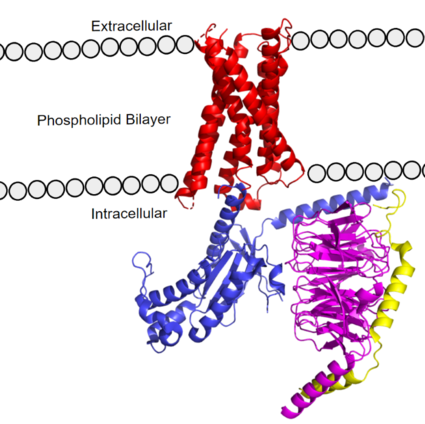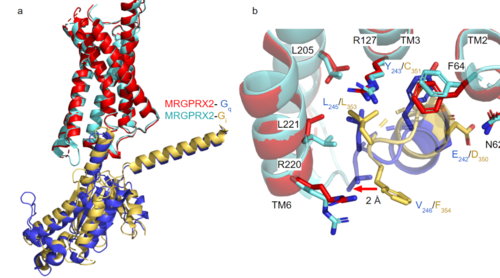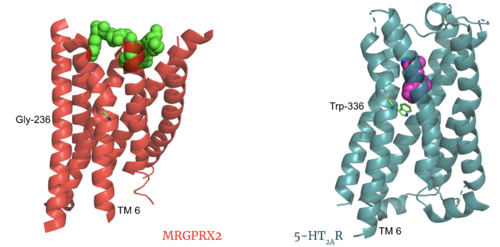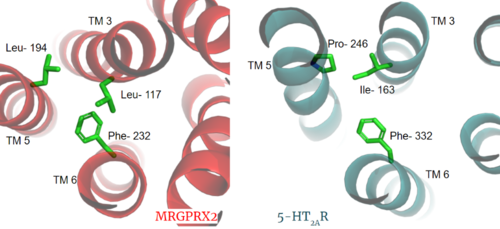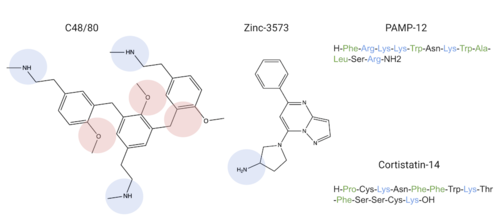Sandbox Reserved 1700
From Proteopedia
(Difference between revisions)
| Line 8: | Line 8: | ||
== Background == | == Background == | ||
GCPR’s or G-Protein Coupled Receptors are a large family of protein receptors that promote cellular signaling and signal transduction <ref name= “Tuteja”>PMID: 19826234</ref>. GPCRs transmit extracellular signals to intracellular messages. Many essential pathways utilize GPCRs, including human vision by the GPCR [https://proteopedia.org/wiki/index.php/Rhodopsin Rhodopsin], and the [https://proteopedia.org/wiki/index.php/Beta2_adrenergic_receptor-Gs_protein_complex_updated adrenaline fight-or-flight response] by the β2-adrenoceptor GPCR. Understanding GPCR’s and how they produce their desired intracellular signal is essential to studying essential cellular pathways, especially in their diseased states. GCPRs are common drug targets, with 475 drugs acting on over 100 GPCRs. An additional 300 drugs are in clinical trial stages, and 20% of those drugs are targeting novel GPCRs <ref name="Hauser">PMID:29075003</ref>. Because of the clinical relevance of GPCRs, new structures provide new avenues for drug development to both treat disease or modulate the harmful side effects. | GCPR’s or G-Protein Coupled Receptors are a large family of protein receptors that promote cellular signaling and signal transduction <ref name= “Tuteja”>PMID: 19826234</ref>. GPCRs transmit extracellular signals to intracellular messages. Many essential pathways utilize GPCRs, including human vision by the GPCR [https://proteopedia.org/wiki/index.php/Rhodopsin Rhodopsin], and the [https://proteopedia.org/wiki/index.php/Beta2_adrenergic_receptor-Gs_protein_complex_updated adrenaline fight-or-flight response] by the β2-adrenoceptor GPCR. Understanding GPCR’s and how they produce their desired intracellular signal is essential to studying essential cellular pathways, especially in their diseased states. GCPRs are common drug targets, with 475 drugs acting on over 100 GPCRs. An additional 300 drugs are in clinical trial stages, and 20% of those drugs are targeting novel GPCRs <ref name="Hauser">PMID:29075003</ref>. Because of the clinical relevance of GPCRs, new structures provide new avenues for drug development to both treat disease or modulate the harmful side effects. | ||
| - | Some cells in the human body that express the MRGPRX2 receptor include mast cells in the skin, intestines, and trachea. <ref name= "Porebski">PMID:30619367<ref><ref name= "Dondalska">PMID: 33101278</ref>. Mast cells are immune cells responsible for triggering inflammatory responses and are densely packed with granules containing inflammatory chemicals <ref name= "Dondalska" />. Mast cells can be activated by either antibodies from the immune response or upon ligands binding to MRGPRX2 receptors on their surface<ref name="McNeil">PMID: 25517090</ref>. Upon activation, mast cells will release granules containing histamine and other inflammatory chemicals in the body, which can trigger a larger inflammatory response <ref name= "Dondalska" /><ref name="McNeil" />. These responses induce common allergic reaction and anaphylaxis symptoms, such as cutaneous itching sensations or airway constriction | + | Some cells in the human body that express the MRGPRX2 receptor include mast cells in the skin, intestines, and trachea. <ref name="Porebski">PMID:30619367<ref><ref name= "Dondalska">PMID: 33101278</ref>. Mast cells are immune cells responsible for triggering inflammatory responses and are densely packed with granules containing inflammatory chemicals <ref name= "Dondalska" />. Mast cells can be activated by either antibodies from the immune response or upon ligands binding to MRGPRX2 receptors on their surface<ref name="McNeil">PMID: 25517090</ref>. Upon activation, mast cells will release granules containing histamine and other inflammatory chemicals in the body, which can trigger a larger inflammatory response <ref name= "Dondalska" /><ref name="McNeil" />. These responses induce common allergic reaction and anaphylaxis symptoms, such as cutaneous itching sensations or airway constriction |
<ref name= "Cao" /><ref name= "Yang" /><ref name="McNeil">PMID: 25517090</ref>. | <ref name= "Cao" /><ref name= "Yang" /><ref name="McNeil">PMID: 25517090</ref>. | ||
| - | Ligands that bind to MRGPRX2 in the natural environment to produce an allergic response include exogenous molecules such as contents of insect venom, molecules like Compound 48/80 (C48/80) or other polycationic molecules<ref name= | + | Ligands that bind to MRGPRX2 in the natural environment to produce an allergic response include exogenous molecules such as contents of insect venom, molecules like Compound 48/80 (C48/80) or other polycationic molecules<ref name= "Dondalska">PMID: 33101278</ref> . They can also respond to endogenous signaling molecules involved in inflammation pathways such as cytokines, anaphylatoxins, or neuropeptides<ref name= "Porebski" />. Many pseudo-allergic drug reactions have been tied to overactivity of MRGPRX2 receptors on mast cells<ref name="McNeil">PMID: 25517090</ref>, so research into receptor-ligand interactions of the MRGPRX2 receptor has the potential to mediate many adverse itching and allergic reaction side effects <ref name= "McNeil">PMID: 25517090</ref>. |
GPCRs are categorized into 6 different classes based on shared sequences and functions. MRGPRX2 is categorized into the [https://proteopedia.org/wiki/index.php/GPCR#Family_A_of_GPCRs Class A] receptor family. However, itch receptors like MGPRX2 have unique structural features from most class A receptors <ref name="Cao">PMID: 34789874</ref><ref name="Yang">PMID: 34789875</ref>. These unique structural features, known as '''novel characteristics''', cause conformational changes throughout the protein that impact what ligands bind to the receptor <ref name= "Yang" />. | GPCRs are categorized into 6 different classes based on shared sequences and functions. MRGPRX2 is categorized into the [https://proteopedia.org/wiki/index.php/GPCR#Family_A_of_GPCRs Class A] receptor family. However, itch receptors like MGPRX2 have unique structural features from most class A receptors <ref name="Cao">PMID: 34789874</ref><ref name="Yang">PMID: 34789875</ref>. These unique structural features, known as '''novel characteristics''', cause conformational changes throughout the protein that impact what ligands bind to the receptor <ref name= "Yang" />. | ||
Revision as of 14:20, 12 April 2022
MRGPRX2 Human Itch G-Protein Coupled Receptor (GPCR)
| |||||||||||
References
- ↑ Tuteja N. Signaling through G protein coupled receptors. Plant Signal Behav. 2009 Oct;4(10):942-7. doi: 10.4161/psb.4.10.9530. Epub 2009, Oct 14. PMID:19826234 doi:http://dx.doi.org/10.4161/psb.4.10.9530
- ↑ Hauser AS, Attwood MM, Rask-Andersen M, Schioth HB, Gloriam DE. Trends in GPCR drug discovery: new agents, targets and indications. Nat Rev Drug Discov. 2017 Dec;16(12):829-842. doi: 10.1038/nrd.2017.178. Epub, 2017 Oct 27. PMID:29075003 doi:http://dx.doi.org/10.1038/nrd.2017.178
- ↑ 3.0 3.1 3.2 3.3 PMID:30619367<ref><ref name= "Dondalska">PMID: 33101278</li> <li id="cite_note-Dondalska-3">↑ <sup>[[#cite_ref-Dondalska_3-0|4.0]]</sup> <sup>[[#cite_ref-Dondalska_3-1|4.1]]</sup> <sup>[[#cite_ref-Dondalska_3-2|4.2]]</sup> Dondalska A, Ronnberg E, Ma H, Palsson SA, Magnusdottir E, Gao T, Adam L, Lerner EA, Nilsson G, Lagerstrom M, Spetz AL. Amelioration of Compound 48/80-Mediated Itch and LL-37-Induced Inflammation by a Single-Stranded Oligonucleotide. Front Immunol. 2020 Sep 30;11:559589. doi: 10.3389/fimmu.2020.559589. eCollection, 2020. PMID:[http://www.ncbi.nlm.nih.gov/pubmed/33101278 33101278] doi:[http://dx.doi.org/10.3389/fimmu.2020.559589 http://dx.doi.org/10.3389/fimmu.2020.559589]</li> <li id="cite_note-McNeil-4">↑ <sup>[[#cite_ref-McNeil_4-0|5.0]]</sup> <sup>[[#cite_ref-McNeil_4-1|5.1]]</sup> <sup>[[#cite_ref-McNeil_4-2|5.2]]</sup> <sup>[[#cite_ref-McNeil_4-3|5.3]]</sup> <sup>[[#cite_ref-McNeil_4-4|5.4]]</sup> <sup>[[#cite_ref-McNeil_4-5|5.5]]</sup> <sup>[[#cite_ref-McNeil_4-6|5.6]]</sup> <sup>[[#cite_ref-McNeil_4-7|5.7]]</sup> McNeil BD, Pundir P, Meeker S, Han L, Undem BJ, Kulka M, Dong X. Identification of a mast-cell-specific receptor crucial for pseudo-allergic drug reactions. Nature. 2015 Mar 12;519(7542):237-41. doi: 10.1038/nature14022. Epub 2014 Dec 17. PMID:[http://www.ncbi.nlm.nih.gov/pubmed/25517090 25517090] doi:[http://dx.doi.org/10.1038/nature14022 http://dx.doi.org/10.1038/nature14022]</li> <li id="cite_note-Cao-5">↑ <sup>[[#cite_ref-Cao_5-0|6.00]]</sup> <sup>[[#cite_ref-Cao_5-1|6.01]]</sup> <sup>[[#cite_ref-Cao_5-2|6.02]]</sup> <sup>[[#cite_ref-Cao_5-3|6.03]]</sup> <sup>[[#cite_ref-Cao_5-4|6.04]]</sup> <sup>[[#cite_ref-Cao_5-5|6.05]]</sup> <sup>[[#cite_ref-Cao_5-6|6.06]]</sup> <sup>[[#cite_ref-Cao_5-7|6.07]]</sup> <sup>[[#cite_ref-Cao_5-8|6.08]]</sup> <sup>[[#cite_ref-Cao_5-9|6.09]]</sup> <sup>[[#cite_ref-Cao_5-10|6.10]]</sup> Cao C, Kang HJ, Singh I, Chen H, Zhang C, Ye W, Hayes BW, Liu J, Gumpper RH, Bender BJ, Slocum ST, Krumm BE, Lansu K, McCorvy JD, Kroeze WK, English JG, DiBerto JF, Olsen RHJ, Huang XP, Zhang S, Liu Y, Kim K, Karpiak J, Jan LY, Abraham SN, Jin J, Shoichet BK, Fay JF, Roth BL. Structure, function and pharmacology of human itch GPCRs. Nature. 2021 Dec;600(7887):170-175. doi: 10.1038/s41586-021-04126-6. Epub 2021, Nov 17. PMID:[http://www.ncbi.nlm.nih.gov/pubmed/34789874 34789874] doi:[http://dx.doi.org/10.1038/s41586-021-04126-6 http://dx.doi.org/10.1038/s41586-021-04126-6]</li> <li id="cite_note-Yang-6">↑ <sup>[[#cite_ref-Yang_6-0|7.0]]</sup> <sup>[[#cite_ref-Yang_6-1|7.1]]</sup> <sup>[[#cite_ref-Yang_6-2|7.2]]</sup> <sup>[[#cite_ref-Yang_6-3|7.3]]</sup> <sup>[[#cite_ref-Yang_6-4|7.4]]</sup> <sup>[[#cite_ref-Yang_6-5|7.5]]</sup> <sup>[[#cite_ref-Yang_6-6|7.6]]</sup> <sup>[[#cite_ref-Yang_6-7|7.7]]</sup> <sup>[[#cite_ref-Yang_6-8|7.8]]</sup> <sup>[[#cite_ref-Yang_6-9|7.9]]</sup> Yang F, Guo L, Li Y, Wang G, Wang J, Zhang C, Fang GX, Chen X, Liu L, Yan X, Liu Q, Qu C, Xu Y, Xiao P, Zhu Z, Li Z, Zhou J, Yu X, Gao N, Sun JP. Structure, function and pharmacology of human itch receptor complexes. Nature. 2021 Dec;600(7887):164-169. doi: 10.1038/s41586-021-04077-y. Epub 2021, Nov 17. PMID:[http://www.ncbi.nlm.nih.gov/pubmed/34789875 34789875] doi:[http://dx.doi.org/10.1038/s41586-021-04077-y http://dx.doi.org/10.1038/s41586-021-04077-y]</li> <li id="cite_note-Kamato-7">[[#cite_ref-Kamato_7-0|↑]] Kamato D, Thach L, Bernard R, Chan V, Zheng W, Kaur H, Brimble M, Osman N, Little PJ. Structure, Function, Pharmacology, and Therapeutic Potential of the G Protein, Galpha/q,11. Front Cardiovasc Med. 2015 Mar 24;2:14. doi: 10.3389/fcvm.2015.00014. eCollection, 2015. PMID:[http://www.ncbi.nlm.nih.gov/pubmed/26664886 26664886] doi:[http://dx.doi.org/10.3389/fcvm.2015.00014 http://dx.doi.org/10.3389/fcvm.2015.00014]</li> <li id="cite_note-Trzaskowski-8">[[#cite_ref-Trzaskowski_8-0|↑]] Trzaskowski B, Latek D, Yuan S, Ghoshdastider U, Debinski A, Filipek S. Action of molecular switches in GPCRs--theoretical and experimental studies. Curr Med Chem. 2012;19(8):1090-109. doi: 10.2174/092986712799320556. PMID:[http://www.ncbi.nlm.nih.gov/pubmed/22300046 22300046] doi:[http://dx.doi.org/10.2174/092986712799320556 http://dx.doi.org/10.2174/092986712799320556]</li> <li id="cite_note-9">[[#cite_ref-9|↑]] Olivella M, Caltabiano G, Cordomi A. The role of Cysteine 6.47 in class A GPCRs. BMC Struct Biol. 2013 Mar 15;13:3. doi: 10.1186/1472-6807-13-3. PMID:[http://www.ncbi.nlm.nih.gov/pubmed/23497259 23497259] doi:[http://dx.doi.org/10.1186/1472-6807-13-3 http://dx.doi.org/10.1186/1472-6807-13-3]</li> <li id="cite_note-Navines-Ferrer-10">[[#cite_ref-Navines-Ferrer_10-0|↑]] Navines-Ferrer A, Serrano-Candelas E, Lafuente A, Munoz-Cano R, Martin M, Gastaminza G. MRGPRX2-mediated mast cell response to drugs used in perioperative procedures and anaesthesia. Sci Rep. 2018 Aug 2;8(1):11628. doi: 10.1038/s41598-018-29965-8. PMID:[http://www.ncbi.nlm.nih.gov/pubmed/30072729 30072729] doi:[http://dx.doi.org/10.1038/s41598-018-29965-8 http://dx.doi.org/10.1038/s41598-018-29965-8]</li></ol></ref>
